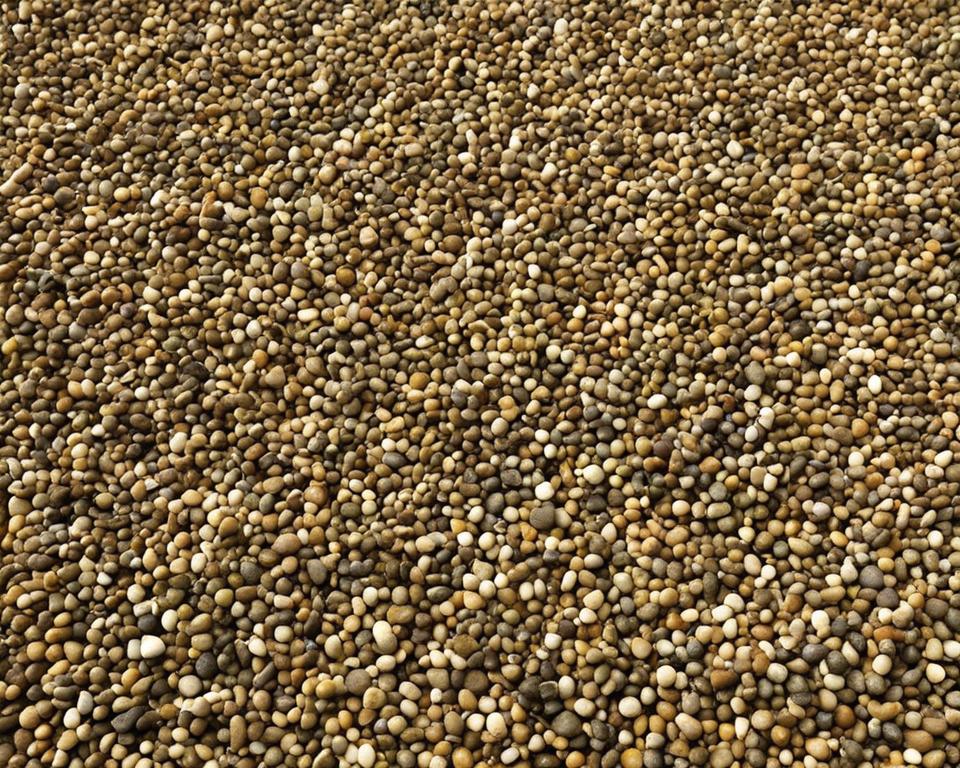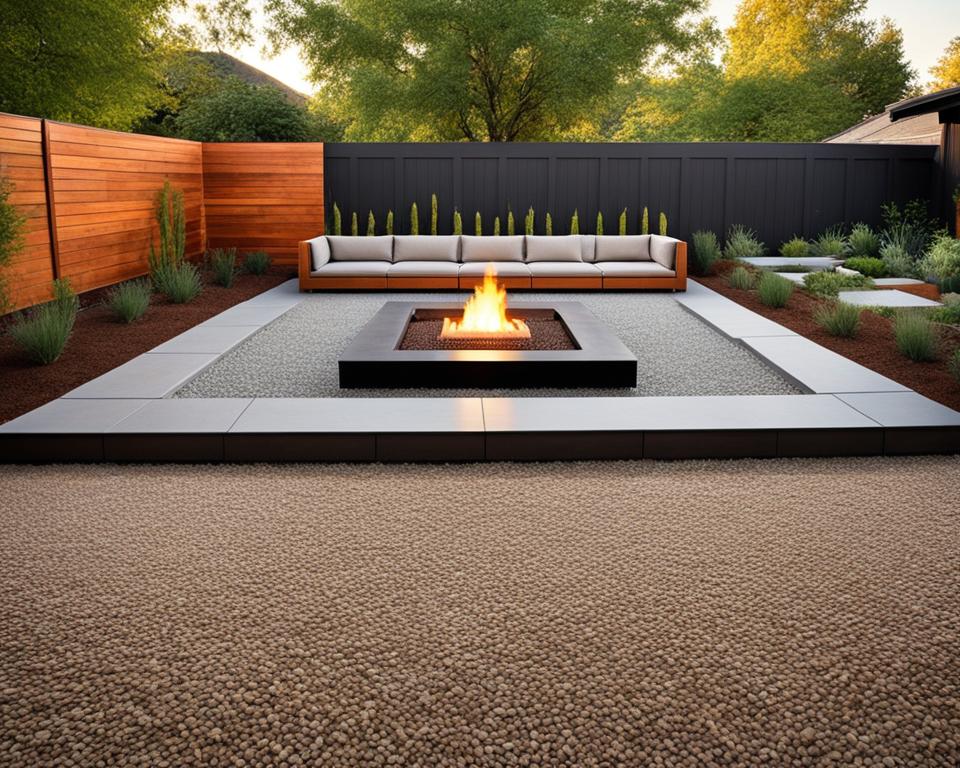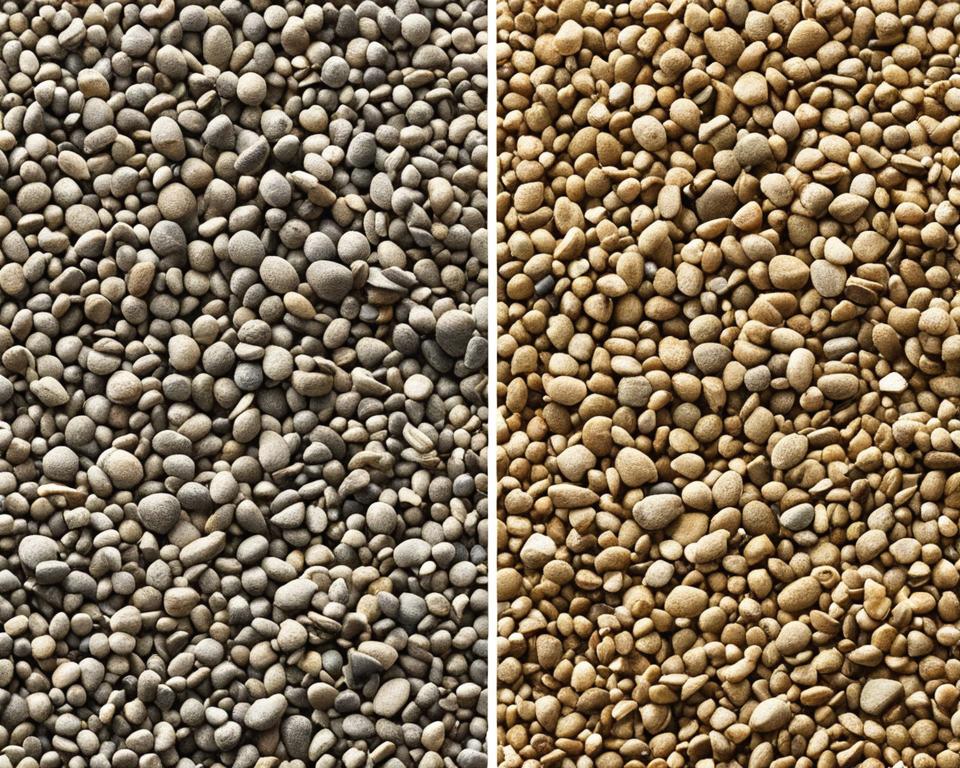Decomposed granite and pea gravel are two popular materials used in landscaping projects. While they may seem similar at first glance, they have distinct differences that can impact your landscaping choices. Understanding the pros and cons of each material is crucial in making an informed decision for your specific needs.
Key Takeaways:
- Decomposed granite and pea gravel are both widely used in landscaping.
- Decomposed granite offers excellent drainage and traction, making it suitable for high-traffic areas.
- Pea gravel has a softer texture and comes in a variety of colors, providing a natural look to your landscape.
- Both materials require regular maintenance to prevent weed growth and keep them looking smooth.
- Consider factors like foot traffic, desired aesthetic, and budget when choosing between decomposed granite and pea gravel.
What is Decomposed Granite?
Decomposed granite (DG) is a granitic rock that has naturally weathered over time into small pieces and silt-like particles. Its unique composition makes it a versatile material suitable for various landscaping projects. DG is commonly used for pathways and rustic patios, providing a natural and earthy aesthetic. It can also be utilized as a topdressing around arid plants, enhancing the landscape’s overall appeal.
DG comes in a reddish-tan color that gradually fades to a lighter tan as it ages, imparting a warm and inviting ambiance to outdoor spaces. This natural color palette blends well with different types of vegetation and complements a wide range of architectural styles.
Key Characteristics of Decomposed Granite
Decomposed granite offers the following key characteristics:
- Relatively inexpensive
- Readily available
- Excellent drainage properties
- Provides a natural and rustic look
One of the significant advantages of using decomposed granite is its cost-effectiveness. Compared to other materials for pathways and patios, such as concrete or natural stone, decomposed granite offers an affordable solution without compromising on quality and aesthetics. Its availability in abundance makes it easily accessible for landscaping projects of any scale.
Another remarkable characteristic of decomposed granite is its excellent drainage capacity. The porous nature of the rock particles allows water to permeate through, reducing the risk of standing water and promoting healthy plant growth. This makes it an ideal choice for areas that require efficient water management.
However, it is essential to consider a few maintenance requirements when using decomposed granite. Due to its loose composition, DG can track inside on shoes, especially when the pathway or patio is adjacent to indoor areas. Regular sweeping or blowing off the granite particles from high traffic areas can help minimize this issue. Additionally, periodic weed control measures should be implemented to prevent unwanted plants from sprouting.
Cost of Decomposed Granite
The cost of decomposed granite can vary depending on factors such as location, quality, and quantity. On average, the price ranges from $30 to $80 per cubic yard. Before starting your project, it is advisable to obtain quotes from local suppliers to determine the specific cost for your area.
Maintenance Requirements for Decomposed Granite
To maintain the beauty and functionality of decomposed granite pathways and patios, follow these maintenance guidelines:
- Sweep or blow off loose particles regularly to prevent tracking indoors
- Apply a weed barrier fabric beneath the decomposed granite layer to minimize weed growth
- Occasionally re-level the surface by raking or adding a thin layer of fresh decomposed granite
- Inspect and address any erosion or displacement caused by heavy rain or foot traffic
- Regularly apply a stabilizer product, such as liquid polymer, to help solidify the decomposed granite surface and improve durability
What is Pea Gravel?
Pea gravel is a small, rounded rock that gets its name from its resemblance to peas. It is commonly used for patio areas, pathways, and filling in between flat rocks like flagstone.

Pea gravel comes in various sizes and colors, ranging from tan to brown and white mixes. It is relatively inexpensive and readily available, making it a popular choice for landscapes.
One of the advantages of pea gravel is its versatility. It can be used to create visually appealing pathways that blend seamlessly with the natural surroundings. The small, rounded shape of the rocks provides a comfortable walking surface and adds a charming aesthetic to outdoor areas.
In addition to pathways and patios, pea gravel is also commonly used for filling in between flat rocks, such as flagstone or steppingstones. This creates a visually pleasing contrast and helps stabilize the rocks in place.
While pea gravel offers many benefits, there are a few considerations to keep in mind. It can be difficult to push wheeled equipment, such as lawnmowers or wheelbarrows, over pea gravel due to its loose nature. Additionally, pea gravel may require regular maintenance to prevent it from straying out of place or migrating into surrounding areas.
Comparing Decomposed Granite and Pea Gravel
When comparing decomposed granite and pea gravel, there are several factors to consider. Both materials offer excellent drainage and durability.
Decomposed Granite
Decomposed granite is rougher in texture and tends to provide better traction, making it suitable for pathways with heavy foot traffic. However, it can be harder on the feet and may track inside on shoes.
Pea Gravel
On the other hand, pea gravel has a softer texture underfoot and comes in a wider range of colors. It is easier on bare feet but can be challenging to walk on with heels or flip-flops.
Both decomposed granite and pea gravel may require periodic maintenance to keep them looking smooth and prevent weed growth. However, the maintenance requirements differ slightly for each material.
“Both decomposed granite and pea gravel offer unique benefits in different situations. Whether you prioritize traction, a softer texture, or color options, understanding the differences will help you make the right choice.”
Cost Comparison
The cost of decomposed granite and pea gravel is similar, but the thickness of the material needed may vary depending on the project. Here is a breakdown of the cost comparison:
| Material | Price (per cubic yard) |
|---|---|
| Decomposed Granite | $40-$70 |
| Pea Gravel | $30-$60 |

As shown in the table, the cost of both materials falls within a similar range. However, it’s essential to consider additional factors such as delivery fees, installation costs, and any necessary site preparations.
Overall, the decision between decomposed granite and pea gravel depends on your specific needs, preferences, and project requirements. Both materials have their unique characteristics and advantages, and it’s crucial to weigh the pros and cons before making a final choice. The cost comparison and maintenance requirements should be taken into account to ensure a long-lasting and visually appealing landscape.
Best Uses for Decomposed Granite and Pea Gravel
When it comes to landscaping, choosing the right materials can make all the difference in achieving the desired aesthetic and functionality. Decomposed granite and pea gravel are two popular options that offer their unique advantages. Let’s explore the best uses for each material to help you make an informed decision for your landscaping project.
Decomposed Granite
Decomposed granite is a versatile material that is commonly used for pathways and rustic patios. Its natural look blends well with a variety of landscape styles, from traditional to contemporary. Here are some of the best uses for decomposed granite:
- Pathways: Decomposed granite creates a durable and visually appealing pathway that blends harmoniously with surrounding vegetation. It provides excellent drainage, making it ideal for areas that receive rain or irrigation.
- Patios: The warm tones and texture of decomposed granite add a touch of rustic elegance to patios. It can be used to create a cozy seating area or extend an existing outdoor living space.
- Raised Garden Beds: Decomposed granite can be used to construct raised garden beds due to its excellent drainage properties. It provides a stable base for plants while allowing excess water to flow away.
Pea Gravel
Pea gravel is another popular material commonly used in landscaping projects. It offers a charming and natural look that complements various outdoor settings. Here are some of the best uses for pea gravel:
- Patios: Pea gravel creates a relaxed and inviting patio area, perfect for entertaining guests or enjoying outdoor meals. Its smooth texture is comfortable underfoot.
- Pathways: The small, rounded stones of pea gravel make it an excellent choice for pathways. It provides a soft and natural surface that is easy to walk on.
- Rock Gardens: Pea gravel works well in rock gardens, where it can be used to highlight specific plants or create a visually interesting texture. Its neutral colors complement a wide range of plantings.
Both decomposed granite and pea gravel have their best uses in landscaping. Consider the specific requirements and desired aesthetic of your project to determine which material will suit your needs best. Whether you choose decomposed granite for its natural and rustic appeal or pea gravel for its soft and inviting texture, your landscaping project is sure to benefit from the unique qualities of these versatile materials.
| Material | Best Uses |
|---|---|
| Decomposed Granite | Pathways, Patios, Raised Garden Beds |
| Pea Gravel | Patios, Pathways, Rock Gardens |

Conclusion
When it comes to choosing between decomposed granite and pea gravel for your landscaping project, there are a few key factors to consider. First, think about the amount of foot traffic the area will receive. If you anticipate heavy use and require better traction and durability, decomposed granite may be the better choice.
On the other hand, if you prioritize a softer texture and a wider range of color options, pea gravel might be more suitable for your needs. Pea gravel is often preferred for creating a natural look and works well around plants. It is commonly used for patio areas, pathways, and filling in between flat rocks.
Additionally, consider your desired aesthetic and budget. Both decomposed granite and pea gravel have their unique visual appeal and can enhance different areas of your landscaping. Ultimately, the decision should be based on what will work best for your specific project.
If you’re unsure about which material to choose, it’s always a good idea to consult with a professional landscaper. They can provide guidance and advice based on their expertise and help you make an informed decision.
FAQ
What is decomposed granite?
Decomposed granite is a granitic rock that has weathered over time into small pieces and silt-like particles. It is commonly used for pathways and rustic patios, and can also be used as a topdressing around arid plants.
What is pea gravel?
Pea gravel is a small, rounded rock that gets its name from its resemblance to peas. It is commonly used for patio areas, pathways, and filling in between flat rocks like flagstone.
What are the differences between decomposed granite and pea gravel?
Decomposed granite is rougher in texture and provides better traction. It can track inside on shoes and may require regular maintenance to prevent weed growth. Pea gravel has a softer texture, comes in a wider range of colors, and can be challenging to walk on with heels or flip-flops.
What are the pros and cons of decomposed granite?
The pros of decomposed granite include its natural look, excellent drainage, and durability. However, it can track inside on shoes and may require regular maintenance to prevent weed growth.
What are the advantages of pea gravel?
Pea gravel offers a softer texture underfoot, a wider range of colors, and is relatively inexpensive. However, it can be challenging to walk on with heels or flip-flops and may require regular maintenance to prevent it from straying out of place.
How do the costs of decomposed granite and pea gravel compare?
The cost of decomposed granite and pea gravel is similar, but the thickness of the material needed may vary depending on the project.
What are the best uses for decomposed granite and pea gravel?
Decomposed granite is often preferred for pathways and rustic patios, while pea gravel is popular for creating a natural look in the landscape and works well around plants.
How do I choose between decomposed granite and pea gravel?
Consider factors such as foot traffic, desired aesthetic, maintenance requirements, and budget. If you require better traction and durability, decomposed granite may be the better choice. If you prefer a softer texture and a wider range of color options, pea gravel may be more suitable. Consult with a professional landscaper for guidance and advice.
